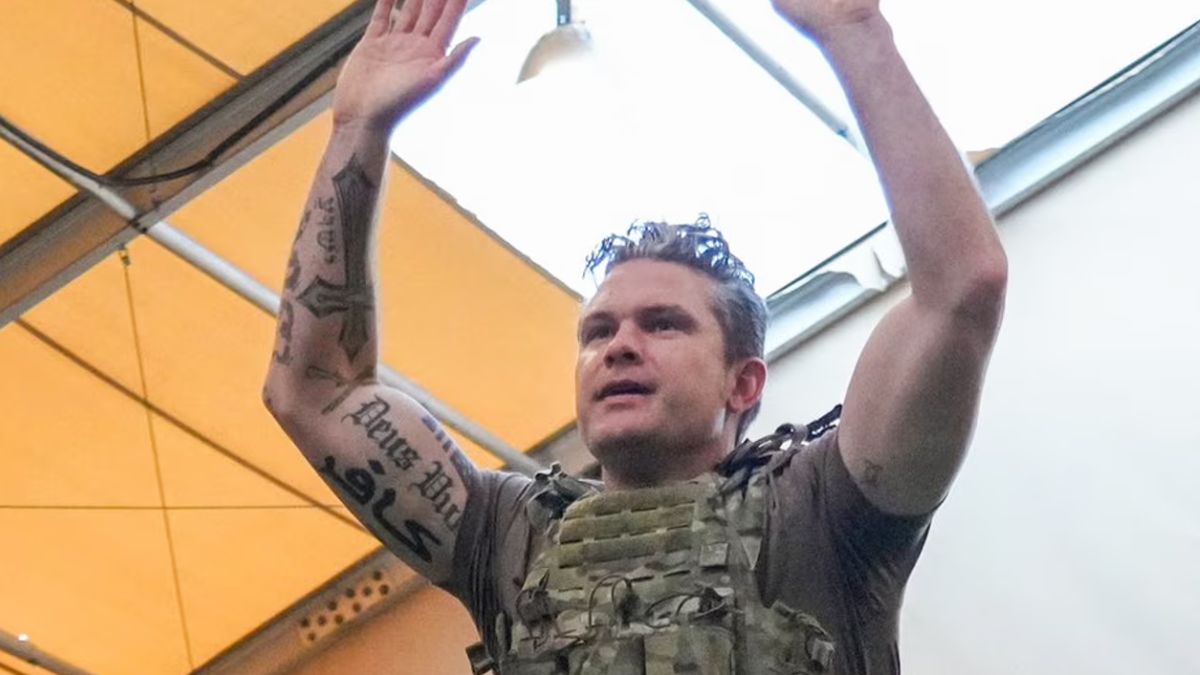Pete Hegseth and his tattoos continue to be a subject of controversy.
The US Secretary of Defence is facing criticism after new images from a military training exercise at Pearl Harbor surfaced, showing a tattoo on his arm.
In the images shared on X on Tuesday, the former Fox News host-turned-defence secretary appeared to have a tattoo with the word “kafir.”
ALSO READ | Will Pete Hegseth or Mike Waltz face the axe from Trump over the Yemen war plan leak?
The phrase was seen alongside another tattoo reading “Deus Vult,” which translates to “God Wills It” and is historically linked to the First Crusade. The tattoo created controversy in November last year.
So, why has his new tattoo sparked controversy? What does ‘kafir’ mean?
Here’s a look.
What does Pete Hegseth’s new tattoo mean?
Hegseth’s tattoos have sparked criticism, with some viewing them as a sign of hostility toward Muslims.
Recent photos circulating on social media reveal that Hegseth has the word “kafir” tattooed in Arabic below his right bicep.
Islamic scholar Abdullah Al Andalusi explains that in the Quran, the term refers to someone who displays “disbelief” or “a rejection of true belief.” Derived from the root K‑F‑R, meaning “to cover” or “to conceal,” the word suggests that a “kafir” recognises the truth of Islam but chooses to reject or hide it.
As author and Cato Institute fellow Mustafa Akyol wrote in a 2019 article, “Kafirs are seen as the sworn enemies of Islam and Muslims.”
Critics argue that its position next to another tattoo reading “Deus Vult”, a Latin phrase historically linked to the First Crusade, sends a message of hostility towards Muslims. The phrase, originating from medieval Christian battle cries, has also been linked to far-right extremist groups in modern times.
Impact Shorts
More ShortsHegseth has over a dozen tattoos, including the Jerusalem Cross on his chest. The symbol, commonly associated with Christian nationalists, led to his removal from National Guard duty at Joe Biden’s inauguration in 2021.
The row over his ‘kafir’ tattoo
Some social media users criticised Hegseth for having a tattoo that could be seen as offensive to Muslims, particularly as the US military aims to reflect a diverse range of faiths.
According to The Guardian, an estimated 5,000 to 6,000 members of the US military practise Islam.
The tattoo, believed to have been done in early 2024, has drawn backlash from advocacy groups and Muslim American civil rights organisations. They argue that a senior official displaying the word “kafir” in this manner signals hostility towards Islam.
Nerdeen Kiswani, a pro-Palestinian activist based in New York, wrote on X, “This isn’t just a personal choice; it’s a clear symbol of Islamophobia from the man overseeing U.S. wars.”
She further stated, “‘Kafir’ has been weaponised by far-right Islamophobes to mock and vilify Muslims. It’s not about his personal beliefs. It’s about how these beliefs translate into policy – how they shape military decisions, surveillance programs, and foreign interventions targeting Muslim countries.”
Nihad Awad, the national executive director of the Council on American-Islamic Relations (CAIR), told Newsweek, “Tattooing the Arabic word kafir – which refers to someone who knowingly denies or conceals fundamental divine truths – on his body is a display of both anti-Muslim hostility and personal insecurity.”
Others defended the tattoo, describing it as a common term used by veterans who served in the Middle East.
“This word is widely recognised among military veterans, especially those who served in the Middle East, as a symbol of defiance against Islamic terrorists,” wrote X user ‘Brother Rachid.’
“It’s commonly seen on stickers, the backs of trucks, T-shirts, and mugs. Personally, I had it on a hat, a mug, and even on the door of my office.”
The controversy over the tattoo comes as Hegseth faces growing scrutiny. Several members of Congress have called for an investigation into him and other officials linked to the Signal leak , which inadvertently revealed operational details of US plans to bomb Yemen. Some representatives have also demanded his resignation.
ALSO READ | What is Signal, the app Trump’s team used to discuss secret war plan? Is its use against the law?
Hegseth and his many controversies
This is not the first time Hegseth has faced controversy over his tattoos.
The US defence secretary has previously displayed tattoos that suggest an interest in “crusader aesthetics,” a theme increasingly associated with the far right.
The veteran, who completed tours in Afghanistan and Iraq and has been awarded the Bronze Star twice, has more than a dozen tattoos covering his right arm and chest.
During his confirmation hearing in February, he addressed the topic of his tattoos, saying, “Things like focusing on extremism have created a climate inside our ranks that feels political when it hasn’t ever been political. Those are the types of things that are going to change.”
In a 2020 interview, Hegseth shared that he got his first tattoo in his late 30s. He had always wanted one, but his father had discouraged him when he was younger.
“I always wanted tattoos. Thankfully, my father dissuaded me early in life because what I wanted out of high school was a basketball hoop with a flaming basketball going through the hoop,” he said.
Meanwhile, calls for Hegseth’s resignation have intensified after reports surfaced of classified military details being shared on the Signal messaging app .
On March 15, he sent a “Team Update” message to a Signal group that included senior officials from the Trump administration, allegedly revealing the exact timing and weapons to be used in upcoming military operations.
“This is when the first bombs will definitely drop,” he wrote, referencing strikes involving F-18 aircraft and Tomahawk missiles launched from the sea.
Defending himself, Hegseth argued that his message was merely a “team update” and insisted that he had not disclosed any “war plans.”
With inputs from agencies
)